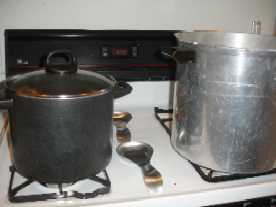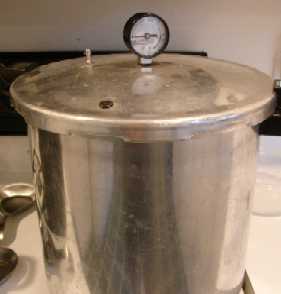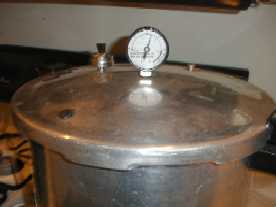I love being able to grab a quart of beans off my shelf to use instead of soaking and cooking them each time.
I got these directions off a wonderful canning site:
http://www.pickyourown.org
How to Make Homemade Canned Dried Beans and Peas (from Lima Beans, Snap Beans, Pole Beans, Runner Beans, Cowpeas, Chickpeas, Peas, etc.)
Kidney, navy and other varieties of dried beans are good candidates for canning or storage. Of course, you can store the dried, too, but some people prefer them canned. In your own home garden, leave the beans on the vine to mature. They will dry naturally.
In canning the dried beans, there is a key tip: Water plays an important part in the final quality of canned beans. The harder the water used for soaking and blanching, the harder and firmer the finished beans. Also, excessive alkalinity will cause the beans to disintegrate somewhat, becoming soft and mushy. However, this will not be seen until after canning them. there's not much you can do about this, but try to avoid "softened" water.
The only other trick is, you really do need a pressure canner. Every university food science department and the government will tell you that it just is not safe to use the water bath bath method; it takes the higher temperatures of the pressure canner to kill the botulism bacteria.
BUT, with a pressure canner it's easy. And although a pressure canner costs $100 to $200 (see this page for pressure canners models, makes and prices), they last a lifetime, and your children and grandchildren may be using it
Directions for Making Canned Dried Beans and Peas
Ingredients and Equipment
|
| |
Recipe and Directions
Step 1 - Selecting the dried beans or peas
The most important step! You need dried beans that are FRESH - not old to begin with! Remove and discard any soft, diseased or spotted beans.
How many dried beans or peas and where to get them
You can grow your own, pick your own, or buy them at the grocery store. About 14 pounds of beans makes 7 quart jars; or 9 pounds is needed per 9 pints. A bushel, which produces anywhere from 13 to 20 quarts, weighs 30 pounds. That works out to an average of 2 pounds of beans per finished quart jar.

Step 2 - Prepare the jars and pressure canner
Wash the jars and lids
This is a good time to get the jars ready! The dishwasher is fine for the jars; especially if it has a "sterilize" cycle. Otherwise put the jars in boiling water for 10 minutes. I just put the lids in a small pot of almost boiling water for 5 minutes, and use the magnetic "lid lifter wand" (available from target, other big box stores, and often grocery stores; and available online - see this page) to pull them out.
Get a large pot of water boiling
We will use this water to pour over the beans and fill each jar with liquid, after we've packed them full of beans. I use the largest pot I have, so that there is plenty of clean, boiling water ready when I need it.

Get the pressure canner heating up
Rinse out your pressure canner, put the rack plate in the bottom, and fill it to a depth of 4 inches with hot tap water. (of course, follow the instruction that came with the canner, if they are different). Put it on the stove over low heat, with the lid OFF of it, just to get it heating up for later on.
Step 3 -Wash the dried beans or peas!
I'm sure you can figure out how to rinse the dried beans or peas in plain cold or lukewarm water.
Step 4 - Soak to Rehydrate the beans
You can use one of the following methods:
- Method 1. Place washed dried beans or peas in a large pot and cover with water. Soak 12 to 18 hours in a cool place. Drain and discard the water.
- Method 2. To quickly hydrate beans, you may cover washed beans with boiling water in a saucepan. Boil 2 minutes, remove from heat, soak 1 hour and drain. Discard the water.
Step 5 - Heat/cook the beans
Cover beans soaked by either method with fresh water and boil 30 minutes. Add 1/4 teaspoon of salt per pint or teaspoon per quart to the jar, if desired. Save the water you cook them in!
Step 6 - Packing the beans in the canning jars
Fill jars with beans or peas . Pack the jars evenly, but be sure to leave 1 inch of space at the TOP of the jar.
Step 8 - Pour boiling water into each packed jar
Fill the space around the beans to 1 inch from the top of the jar with the water you cooked the beans in. That 1 inch space is called "headspace" and is needed for expansion during heading. Use a ladle or pyrex measuring cup to carefully fill each packed jar with water from pot of boiling water. The beans should be covered and there should still be 1 inch of airspace left in the top of each jar. Be careful not to burn yourself, (or anyone else - children should be kept back during this step!)
Step 9 - Put the lids and rings on
Put the lids on each jar and seal them by putting a ring on and screwing it down snugly (but not with all your might, just "snug").
Step 10 - Put the jars in the canner and the lid on the canner (but still vented)
Using the jar tongs, put the jars on the rack in the canner. By now the water level has probably boiled down to 3 inches. If it is lower than that, add more hot tap water to the canner. When all the jars that the canner will hold are in, put on the lid and twist it into place, but leave the weight off (or valve open, if you have that type of pressure canner).
 Step 11 - Let the canner vent steam for 10 minutes
Step 11 - Let the canner vent steam for 10 minutes
Put the heat on high and let the steam escape through the vent for 10 minutes to purge the airspace inside the canner.
 Step 12 - Put the weight on and let the pressure build
Step 12 - Put the weight on and let the pressure build
After 10 minutes of venting, put the weight on and close any openings to allow the pressure to build to 11 to 13 pounds in a dial-type gauge canner - shown in the photos (or at 10 to 15 pounds pressure in a weighted gauge canner.
Step 13 - Process for the required time
Once the gauge hits 11 pounds (or 10 pounds in a weighted gauge type), start your timer going - for 75 minutes for pint jars and quarts for 90 minutes. Adjust the heat, as needed, to maintain 10 pounds of pressure.
Pressure required depends on the altitude where canning is being done. Note: the chart below will help you determine the right processing time and pressure, if you are above sea level.
It is important to learn how to operate your pressure canner by reading the owner's manual that came with your particular canner. If you can not find your owner's manual, you can obtain find one online: Here is where to find some common manufacturer's manuals:
or by contacting the company that made your canner. Give the model number to the manufacturer, and they will send you the right manual. More notes on pressure canners from Colorado State University.
| Recommended process time for Dried Beans in a dial-gauge pressure canner. | |||||
| Minimum Canner Pressure (PSI) at Various Altitudes | |||||
| Jar Size | Process Time | 0 - 2,000 ft | 2,001 - 4,000 ft | 4,001 - 6,000 ft | 6,001 - 8,000 ft |
| Pints | 75 min | 11 lb | 12 lb | 13 lb | 14 lb |
| Quarts | 90 | 11 lb | 12 | 13 | 14 |

Step 14 - Turn off the heat and let it cool down
After 75 minutes for pints, 90 minutes for quart jars, turn off the heat and let the canner cool down. After the pressure drops to zero (usually, you can tell but the "click" sound of the safety release vents opening, as well as but the gauge. Wait 3 more minutes, then open the vent or remove the weight and allow the steam to escape.
Step 15 - Remove the jars
Lift the jars out of the water and let them cool on a wooden cutting board or a towel, without touching or bumping them in a draft-free place (usually takes overnight), here they won't be bumped. You can then remove the rings if you like. Once the jars are cool, you can check that they are sealed verifying that the lid has been sucked down. Just press in the center, gently, with your finger. If it pops up and down (often making a popping sound), it is not sealed. If you put the jar in the refrigerator right away, you can still use it. Some people replace the lid and reprocess the jar, then that's a bit iffy. If you heat the contents back up, re-jar them (with a new lid) and the full time in the canner, it's usually ok. You're done!
Other Equipment:
 From left to right:
From left to right:
- Jar lifting tongs
helpful to pick up hot jars - Lid lifter
- to remove lids from the pot
of hot water - Lid
- disposable - you may only
use them once - Ring
- holds the lids on the jar until after
the jars cool - then you don't need them - Canning jar funnel
- to fill the jars
Frequently Asked Questions
Q. Is it safe to can dried beans or peas in a traditional water bath? If so how long do you do process them?
A. The answer, quite simply is no. Quoting from the Ohio State University Extension's Fact Sheet:
"Pressure canning is the only safe method for home canning vegetables. Clostridium botulinum is the bacterium that causes botulism food poisoning in low-acid foods, such as vegetables. The bacterial spores are destroyed only when the vegetables are processed in a pressure canner at 240 degrees Fahrenheit (F) for the correct amount of time.Clostridium botulinum is the bacterium commonly found in vegetables and meats. It is harmless until it finds itself in a moist, low-acid, oxygen-free environment or a partial vacuum. Under these conditions, the bacterium can grow and produce toxins dangerous to people and animals.
Do not process (low acid) vegetables using the boiling water bath because the botulinum bacteria can survive that method.
Can fruits and vegetables be canned without heating if aspirin is used? No. Aspirin should not be used in canning. It cannot be relied on to prevent spoilage or to give satisfactory products. Adequate heat treatment is the only safe procedure.Is it safe to can dried beans or peas in a boiling water bath if vinegar is used? No. Recommended processing methods must be used to assure safety. Recommended processing times cannot be shortened if vinegar is used in canning fresh vegetables. (This does not refer to pickled vegetables.)
Salt and sugar are not preservatives for vegetables: they are added to stabilize and improve flavor, but will not prevent spoilage.
Salicylic acid is also NOT a preservative. The University of Illinois reports:
Using Aspirin for Canning
Several years ago, a recipe circulated using aspirin to acidify tomatoes and dried beans or peas for canning. Aspirin is not recommended for canning. While it contains salicylic acid, it does not sufficiently acidify tomatoes or dried beans or peas for safe hot water bath canning. dried beans or peas are low acid foods and may only be processed safely in a pressure canner. Lemon juice or vinegar is recommended to acidify tomato products for safe water bath processing.
Think of it like smoking. We all know someone who smoke their entire life and lived to be 90. But the cemeteries are filled with the vast majority who didn't. You'll hear people say "my grandmother did it that way for 20 years". But of course, the people who died from food poisoning aren't around and often didn't have descendents to tell their tale...
Pressure canners!
If you want to can low-acid foods such as red meats, sea food, poultry, milk, and all fresh vegetables with the exception of most tomatoes, you will need a pressure canner. These foods fit into the low acid group since they have an acidity, or pH level, of 4.6 or greater. The temperature which must be reached and maintained (for a specified amount of time) to kill the bacteria is 240 F. Pressure canning is the only canning method recommended safe by the U.S.D.A. for low-acid foods such as vegetables, meats, and fish. Ordinary water bath canners can only reach 212 F and can not to kill the types of bacteria that will grow in low acid foods. This temperature can be reached only by creating steam under pressure as achieved in quality pressure canners.
There are several manufacturers of pressure canners. The two leading ones are Presto and All American (Wisconsin Aluminum). They are more expensive than water bath canners, but extremely well built - I bought mine in 1988 and it still looks and works like new!
| |
No comments:
Post a Comment